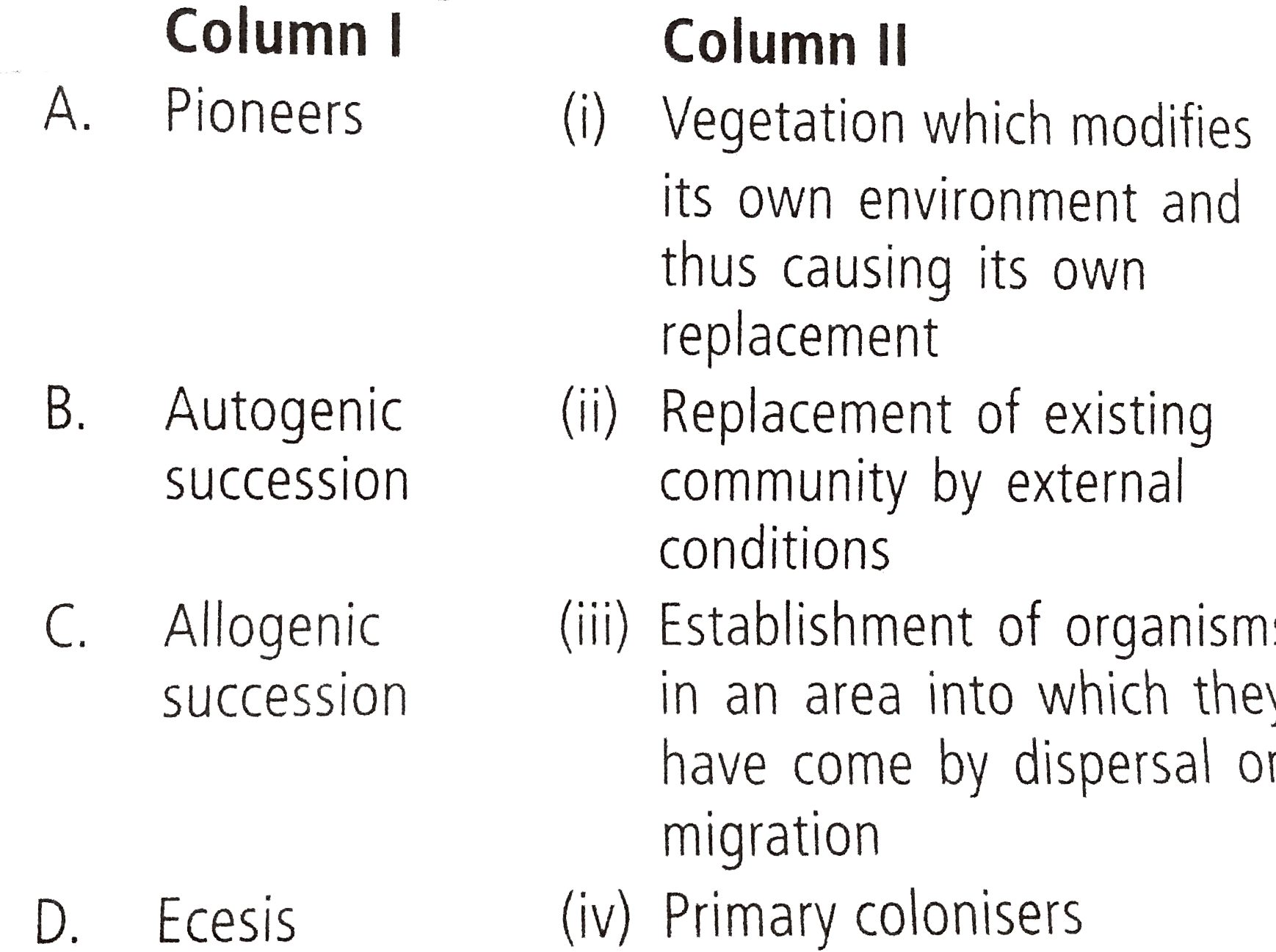Match column I with column II and select the correct option from the given codes
A-(iii),B-(iv),C-(ii),D-(v)
A-(i),B-(iv),C-(ii),D-(v)
A-(iii),B-(ii),C-(iv),D-(v)
A-(ii),B-(v),C-(iii),D-(i)
The correct Answer is:A
To solve the matching question between Column I and Column II, we will analyze each item in Column I and find the appropriate match in Column II based on the principles of inheritance and variation.
1. Match A: Dihybrid test cross
- A dihybrid test cross involves crossing an individual with a heterozygous genotype (e.g., AaBb) with a homozygous recessive individual (e.g., aabb).
- The expected phenotypic ratio from a dihybrid test cross is 1:1:1:1.
- Match: A → (iii) 1:1:1:1
2. Match B: Law of segregation
- The Law of Segregation states that during gamete formation, the alleles for a trait segregate from each other so that each gamete carries only one allele for each gene.
- This concept is often referred to as the purity of gametes.
- Match: B → (iv) Purity of gametes
3. Match C: Law of independent assortment
- The Law of Independent Assortment states that alleles of different genes assort independently of one another during gamete formation.
- In a dihybrid cross, this results in a phenotypic ratio of 9:3:3:1.
- Match: C → (ii) Dihybrid cross
4. Match D: ABO blood group in man
- The ABO blood group system is an example of multiple allelism, where there are three alleles (IA, IB, and IO) that determine the blood type.
- This system also exhibits co-dominance between IA and IB.
- Match: D → (v) Multiple allelism
Final Matching:
- A → (iii) 1:1:1:1
- B → (iv) Purity of gametes
- C → (ii) Dihybrid cross
- D → (v) Multiple allelism
Conclusion:
The correct matches are:
- A - (iii)
- B - (iv)
- C - (ii)
- D - (v)
- A dihybrid test cross involves crossing an individual with a heterozygous genotype (e.g., AaBb) with a homozygous recessive individual (e.g., aabb).
- The expected phenotypic ratio from a dihybrid test cross is 1:1:1:1.
- Match: A → (iii) 1:1:1:1
- The Law of Segregation states that during gamete formation, the alleles for a trait segregate from each other so that each gamete carries only one allele for each gene.
- This concept is often referred to as the purity of gametes.
- Match: B → (iv) Purity of gametes
- The Law of Independent Assortment states that alleles of different genes assort independently of one another during gamete formation.
- In a dihybrid cross, this results in a phenotypic ratio of 9:3:3:1.
- Match: C → (ii) Dihybrid cross
- The ABO blood group system is an example of multiple allelism, where there are three alleles (IA, IB, and IO) that determine the blood type.
- This system also exhibits co-dominance between IA and IB.
- Match: D → (v) Multiple allelism
- A → (iii) 1:1:1:1
- B → (iv) Purity of gametes
- C → (ii) Dihybrid cross
- D → (v) Multiple allelism
The correct matches are:
- A - (iii)
- B - (iv)
- C - (ii)
- D - (v)
Topper's Solved these Questions
- PRINCIPLES OF INHERITANCE & VARIATIONBOOK - NCERT FINGERTPS ENGLISHCHAPTER - PRINCIPLES OF INHERITANCE & VARIATIONEXERCISE - HOTS
5 Videos
- PRINCIPLES OF INHERITANCE & VARIATIONBOOK - NCERT FINGERTPS ENGLISHCHAPTER - PRINCIPLES OF INHERITANCE & VARIATIONEXERCISE - EXEMPLAR
17 Videos
- PRACTICE PAPERSBOOK - NCERT FINGERTPS ENGLISHCHAPTER - PRACTICE PAPERSEXERCISE - Practice paper
150 Videos
- REPRODUCTION IN ORGANISMBOOK - NCERT FINGERTPS ENGLISHCHAPTER - REPRODUCTION IN ORGANISMEXERCISE - All Questions
137 Videos
Similar Questions
Match column I with column II and select the correct option from the given codes
Column IColumn IIA.Turner's syndrome(i)TrisomyB.Linkage(iiAA + XOC.Y-chromosome(iii)MorganD.Down's syndrome(iv)TDF
View SolutionMatch column I with column II and select the correct option from the given codes
Column IColumn IIA.Autopolyploidy(i)2n+1B.Trisomy(ii)AAAAC.Allopolyploidy(iii)AABBD.Nullisomy(iv)2n-2
View Solution
Knowledge Check
Match column I with II column II and select the correct option from the given codes .
 AA-(ii), B-(iii), C-(iv), D-(i)BA-(iii), B-(ii), C-(i), D-(iv)CA-(iii), B-(ii), C-(iv), D-(i)DA-(i), B-(ii), C-(iii), D-(iv)
AA-(ii), B-(iii), C-(iv), D-(i)BA-(iii), B-(ii), C-(i), D-(iv)CA-(iii), B-(ii), C-(iv), D-(i)DA-(i), B-(ii), C-(iii), D-(iv)Match column I and II and select the correct option from the given codes.
 AA-(iii),B-(iv),C-(i), D-(v), E-(ii)BA-(iii),B-(i),C-(iv), D-(v), E-(ii)CA-(iii),B-(iv),C-(v), D-(i), E-(ii)DA-(ii),B-(iv),C-(i), D-(v), E-(iii)
AA-(iii),B-(iv),C-(i), D-(v), E-(ii)BA-(iii),B-(i),C-(iv), D-(v), E-(ii)CA-(iii),B-(iv),C-(v), D-(i), E-(ii)DA-(ii),B-(iv),C-(i), D-(v), E-(iii)Mathc column I with column II and select the correct option from the given codes.
 AA-(ii), B-(iii), C-(iv), D-(i), E-(v)BA-(v), B-(iv), C-(iii), D-(i), E-(ii)CA-(i), B-(iii), C-(iv), D-(ii), E-(v)DA-(i), B-(iv), C-(iii), D-(ii), E-(v)
AA-(ii), B-(iii), C-(iv), D-(i), E-(v)BA-(v), B-(iv), C-(iii), D-(i), E-(ii)CA-(i), B-(iii), C-(iv), D-(ii), E-(v)DA-(i), B-(iv), C-(iii), D-(ii), E-(v)
Match column I with column II and select the correct option from the given codes.
Column IColumn IIA.Labeo rohita(i)Red junglefowlB.Gallus gallus(ii)RohuC.Bos indicus(iii)Tussar silkmothD.Anteraea mylitta(iv)Cattle
View SolutionMatch column I with column II and select the correct option from the given codes.
Column IColumn IIA. Salivary amylase(i)ProteinsB. Bile salts(ii)Milk proteinsC. Rennin(iii)StarchD. Pepsin(iv)Lipids
View SolutionMatch column I with column II and select the correct option from the given codes
Column IColumn IIA.Gregor J, Mendel(i)Chromosomal theory of inheritanceB.Sutton and Boveri(ii)Laws of inheritanceC.Henking(iii)DrosophilaD.Morgan(iv)Discovered X-body
View SolutionMathc column I with column II and select the correct option from the given codes.

View SolutionMatch column I with column II and select the correct option from the given codes
Column IColumn IA.α−1−antitrypsin(i)AIDSB.Transposon(ii)Gene therapyC.ELISA(iii)EmphysemaD.Retroviral vector(iv)Mobile genetic element
View Solution
